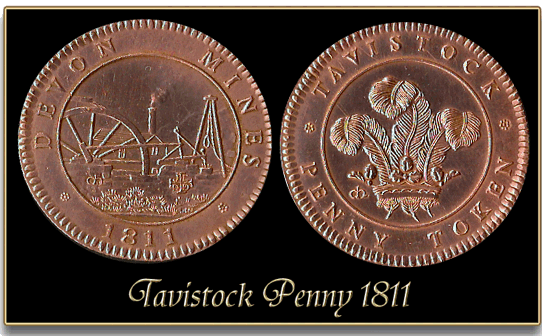
Throughout the 18th century there was a dearth of small change coinage throughout Great Britain due to the fact that the mint could not keep up with the demand for the lower denomination coins. To confound the problem there were also numerous forgeries in circulation which tended to lose people’s confidence in the currency. As if things were bad enough the Napoleonic Wars then came along and further acerbated the coin shortage. To overcome this dilemma various councils, traders or businesses began to issue their own form of currency in the form of ‘tokens’ albeit they had no legal tender status. In 1787 the Anglesey based Parys Mine Company were the first mining company to issue tokens in order to pay their workers which were then redeemed for a whole range of goods.
So, to a more local level and to Wheal Friendship which at one time was said to be the largest copper mine in the world and dates back to at least 1714. It was this mine that employed a manager called John Taylor, it is reported that he took up this post whilst only 19 years of age. It is also said that he was a compassionate man who regarded the welfare of the men, women and children who worked at the mine his prime concern. The work was hard, the hours long and the remuneration very small, all of which made for a hard life. Due to the shortage of coin as mentioned above and the fact that the low mine wages meant the workers needed these small denomination coins in order to be paid there soon became a problem. This coupled with the commonplace occurrence of the mine owners sending the wages to the mine late made buying the day to day necessities a nightmare. In 1811 John Taylor decided to overcome this situation by adopting the same policy as used by the Parys Mine Company and introduced tokens to his workers. In so ways this was a risky decision as nationwide the token system had been open to abuse and extortion by the businesses exchanging their goods, often at a very much higher rate. But presumably the situation for the mine workers meant that some form of coinage was better than none. In the event of a coin shortage or late wage delivery the workers would be paid in tokens. These would then be used in the local shops, pubs etc in exchange for goods or services, in a way similar to today’s credit cards. The local traders would then take the tokens to ‘Count House’ of the issuing mine where they would be exchanged for normal currency. These tokens soon became known as ‘Tavistock Pennies’ and soon found themselves in circulation amongst the various Tavistock traders. There are certainly memories of the local shops in the village of Mary Tavy accepting the tokens.

As can be seen from the photograph above, on one side there is a depiction of the Price of Wales’ plume of feathers thus representing the Duchy of Cornwall and is accompanied by the wording ‘Tavistock Penny Token‘. On the other side there is a mining scene with a depiction of what was possibly known as an Engine House and wheel along with the words; ‘Devon Mines 1811′. There are two suggestions as to exactly what mine is shown on the Tavistock Penny, some say it’s Wheal Luscome whilst others suggest it is Wheal Friendship. One thing the Tavistock Penny was noted for was its weight which being made from copper and measuring 34mm in diameter by 3mm deep was never easily lost. There is also a notion that the poor and needy also benefited from these tokens as at the time they were the only low value coins that could be used fro charitable donations.
Today an original Tavistock Penny will fetch around £50 at auction and replicas can be bought for £4.95, incidentally the above photographs were taken of a replica token, unfortunately I don’t own an original 🙁 Interestingly enough when using a comparison date of 2010 the 1811 one penny token would be worth around 24p at today’s retail price index or £2.94 when using the average earnings calculation. Today the fame of the Tavistock Penny has spread into the world of Morris dancing as the ‘Wheal Sophia Morris’ have used the token’s design in its emblem.
 Legendary Dartmoor The many aspects past and present of Dartmoor
Legendary Dartmoor The many aspects past and present of Dartmoor
